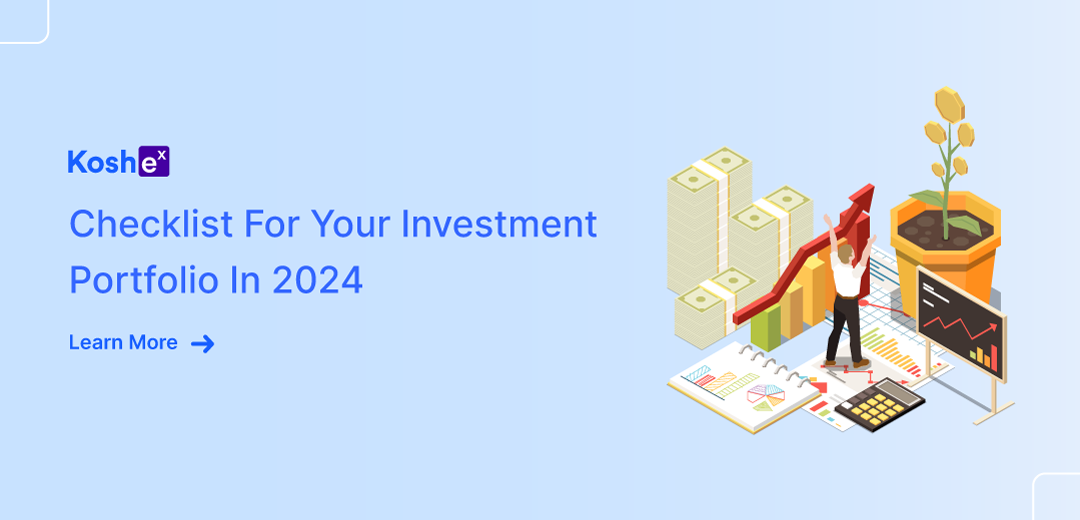It’s a well-known concept that the value of money diminishes with time, and this theory is known as the time value of money.
Investing is the best way to keep the value of money intact. Investing your funds in an avenue that offers a higher rate of returns than inflation helps you grow your money with time and keep your purchasing power unchanged.
Investing does not mean parking a lump sum in an asset class. You can start with a small sum, say investing Rs.1,000 monthly, to accumulate funds for your financial goals.
Of course, at the current time, Rs.1,000 may sound very less, but it’s an excellent starting point for your investment journey. Koshex enables you to start your investment journey with small amounts spread across various asset classes.
Top 9 Ways To Invest Rs.1,000
A few best options to invest Rs.1,000 monthly are
1. Mutual Funds
Mutual funds gather money from several investors and park them in various asset classes, such as bonds, stocks, money market instruments, and more. You can invest in mutual fund schemes either through the Systematic Investment Plan (SIP) or a lump sum.
SIPs
This is a convenient way to invest in mutual funds; it lets you put a fixed sum in schemes at regular intervals. Investors can start their SIP in mutual funds with a minimum of Rs.500 each month. If you have Rs.1,000, you can either invest the entire amount in one fund or divide it and invest in two funds of your choice. Investing in two funds with different investment themes is an excellent way to grow your money.
Though SIP has several advantages, Rupee Cost Averaging is the most important one. Rupee Cost Averaging allows investors to buy more units of funds when the market is on the downswing and fewer units when it’s on the upswing. In this way, it brings down the average buying cost per unit.
Suppose the NAV of a fund in February 2022 was Rs.25, and a SIP of Rs.1,000 can fetch 40 units. In March 2022, the market went down, and the NAV of the same fund reached Rs.20. Therefore, the SIP of Rs.1,000 will get 50 units in March. With this, the average buying cost of 90 units of the fund will be Rs.22.22 (Rs.2,000/90).
2. Corporate Bonds
Companies issue bonds to meet fund requirements for various activities. The minimum amount required to invest in a corporate bond is Rs.1,000. When you buy a corporate bond, you lend the money to the company. And in return, the company will pay you interest either on maturity or at pre-defined intervals. Apart from this, you will get the principal back on maturity.
Normally, corporate bonds offer higher interest rates than FDs. Further, corporate bonds are debt instruments; hence, investing in them is a better way to diversify your portfolio. You can identify the quality of these bonds from their credit ratings. Corporate bonds with an AAA rating are the safest, indicating the issuer can repay the investors on time.
3. Smart Deposit Schemes
Smart deposit schemes are liquid funds that invest in securities with a maturity of not more than 91 days. They are alternatives to regular bank savings accounts and offer higher interest rates than saving accounts.
You can invest your surplus money every month in a smart deposit to earn more returns than keeping them idle just in a savings account. The minimum requirement of investment amount varies from scheme to scheme. You start investing in the Smart Deposit of Koshex with as low as Rs.500.
Check out a few advantages of smart deposits:
o High liquidity
o Low risks
o No lock-in period
o No entry or exit loads
o Low annual fees
o Instant withdrawal
4. Individual Stock
Investing in individual stocks is another way to invest Rs.1,000 monthly. You can buy the shares of the same company or invest in the shares of different companies each month. But before investing in individual companies, you must thoroughly analyze their financials. Putting money in companies with robust fundamentals and promising businesses helps you grow your wealth exponentially.
Undoubtedly, there is no better ground for beginners to try various investment strategies than the stock market.
Some of the most popular investment strategies are
o Value investing
o Growth Investing
o Income investing
o Passive investing
o Dividend Investing
5. Exchange Traded Funds (ETFs):
ETFs track a commodity, an index, bonds, or a basket of assets. They are funds that can be traded on stock exchanges like common stocks. And just like the price of shares, their prices also move up and down during trading hours.
ETFs are sold in units, and you can buy or sell them via a broker or directly through your trading account. Investors can buy as little as one unit of any ETF. As ETFs trade on a per-unit basis, there is no minimum investment requirement for them.
Low cost is the most significant advantage of ETFs. They are much cheaper than mutual funds as their transaction costs and management fees are less. Diversification is another advantage of ETFs. Buying even a single unit gives you exposure to a basket of securities and reduces the risk of losses.
6. Digital gold
Investing in digital gold is the best way to take advantage of the increasing price of gold without holding them physically. Digital gold allows you to buy, sell and accumulate gold virtually. Investors can purchase digital gold through online platforms for a small sum.
When an investor buys digital gold, an equivalent quantity of physical gold will be stored in insured vaults by the seller on their behalf. At the same time, the buyer need not bother about the purity of the gold as it will be 24k gold or 99.99% pure.
You can sell your digital gold anytime and anywhere at the market rate. Investors can redeem it for cash or get physical gold as coins or ornaments.
7. Public Provident Fund (PPF)
PPF is another excellent option to invest Rs.1,000 monthly. It offers a higher rate of return than most debt instruments, and the government revises the interest rate of PPF quarterly. PPF has a lock-in period of 15 years, but partial withdrawals are allowed from the 7th financial year after the account opening.
The biggest advantage of PPF is its EEE tag, i.e., there will be no tax on investment, interest, and maturity. Besides, investments in PPF are eligible for a tax exemption under Section 80C of the IT Act.
8. National Pension System (NPS)
NPS is a market-linked government scheme that allows Indian citizens to save for their retirement. Besides, the contributions to NPS are eligible for tax exemption under Section 80C of the IT Act. Subscribers can also enjoy tax benefits under subsection 80CCD (1B) for investments up to Rs.50,000 in their NPS account.
NPS has two types of accounts: Tier I and Tier II. The Tier I account is the compulsory account, while Tier II is the optional account. The investments made to your Tier I account will be locked until you turn 60. At the same time, a Tier II account functions like a saving account and does not have a lock-in period.
At the time of account opening, you must deposit Rs.500 in the Tier I account; for Tier II accounts, it’s Rs.1,000.
Further, subscribers must make at least one contribution in a financial year to keep their Tier I account active, and the minimum contribution per financial year is Rs.1,000. On the other hand, the minimum amount per contribution for the Tier II account stands at Rs.250.
9. Fixed deposits (FDs)
When it comes to investments, fixed deposits are one of the most preferred options for Indian households. Apart from banks, many corporates also offer FDs these days. Usually, corporate FDs have higher interest rates than bank FDs.
A few factors that attract the populace towards FDs are:
o Flexible tenure
o Easy liquidity
o Assured rate of returns
o Simple rules
Investing Rs.1,000 monthly in an FD will be a good start to your investment journey, as their risk is minimal and rules are not complex.
Conclusion
An excellent financial discipline is vital in achieving your financial goals on time. Developing the habit of saving and investing is the core of it. Financial discipline also includes making a budget and sticking to it, controlling expenses, reducing debt and, regularly monitoring financial investments.
Keep your portfolio simple and easy to manage. Use your savings and bonuses to diversify your portfolio and as the wise saying goes, ‘Don’t put all eggs in one basket’. Track all personal finance-related regulatory notifications and trending developments and make your decisions only after thorough research.
Whenever you have a salary increase, put it aside and invest a little more. You need not wait to accumulate lakhs of rupees to start your investment journey. Instead, you can begin with a small sum. Investing Rs.1,000 monthly is a good beginning; gradually, you can raise the amount to reach your goals swiftly.
Sign up with Koshex to kick-start your investment journey today.
FAQs
Can I start a SIP with a debt fund?
Yes, you can invest in debt funds through the SIP route.
What is NAV?
Net Asset Value or NAV is the per unit value of funds. The NAV of a fund is computed by dividing its total net asset by the total number of units issued.









Leave a Comment